Did you know that female wolf spiders can carry up to 100 or more babies on their backs at once? These amazing arachnids belong to the Lycosidae family. They are found all over North America and the world. With over 2,300 known species, they are known for their hunting skills, sharp eyesight, and complex courtship rituals.
Wolf spiders live on the ground and don’t spin webs to catch prey. They use their speed and agility to chase down insects like ants and flies. They have powerful legs and many ways to catch different insects. Scientists and nature lovers find them very interesting.
Learning about wolf spiders reveals a lot about these amazing arachnids. They show great care for their babies and help the ecosystem. Their survival strategies and adaptations are truly inspiring.
Maternal Dedication: A Mother’s Love
Wolf spiders are known for their amazing care for their young. They stand out among other spiders. Females carry their egg sacs on their spinnerets until the eggs hatch. They protect the sac from predators and parasites.
Egg Sac Protection and Hatching Process
When the spiderlings come out, the mother helps open the sac. This lets the babies come out safely. This act greatly helps the babies survive and is rare among spiders.
Some spider moms, like the Stegodyphus lineatus, even break down their own midgut. They do this to make a special food for their newborns.
Carrying Spiderlings on Their Back
After the spiderlings hatch, they climb onto the mother’s back. She carries them for a few days. This gives the baby spiders time to grow before they go off on their own.
This parental behavior shows how dedicated wolf spider moms are. They make sure their babies have a good start in life.
“This study marks the first instance of elucidating the mechanism behind suicidal maternal behavior in an arthropod.”
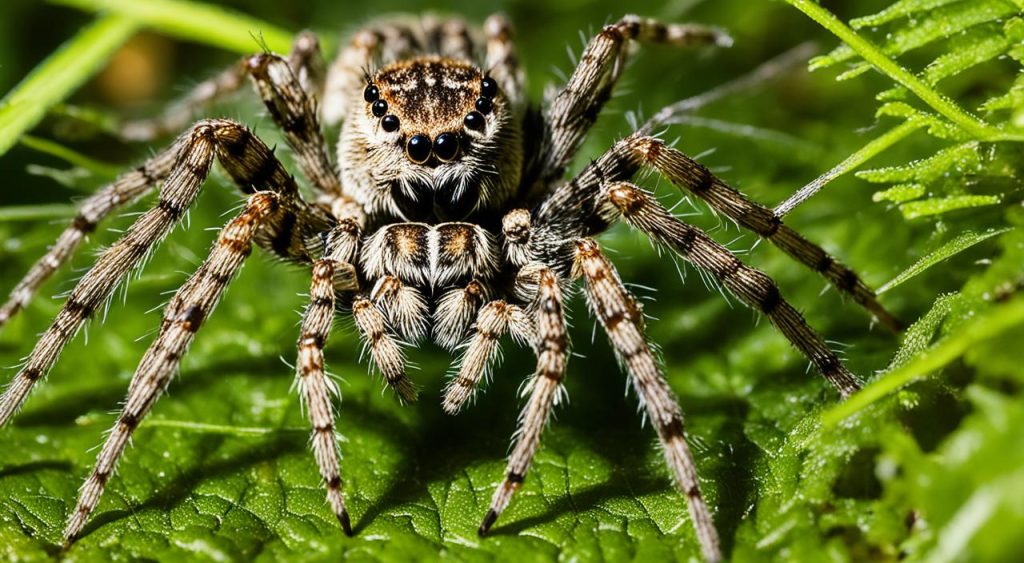
Wolf Spider With Babies
Seeing a mother wolf spider carry her babies on her back is amazing. These spiders show great love and care for their young. They can carry up to 100 baby spiders on their back, keeping them safe and fed until they grow up.
After the eggs hatch, the spiderlings stick to their mom’s body for warmth and safety. This is special because wolf spiders are the only spiders that do this. The baby spiders, or spiderlings, stay with their mom for weeks before they can survive on their own.
Wolf spiders are not usually dangerous to people because their venom isn’t strong. Seeing a mom wolf spider with her babies can be both interesting and a bit scary. But, these spiders are important in nature. They help control insect numbers and keep their environments balanced.
| Characteristic | Details |
|---|---|
| Egg Sac Size | Wolf Spiders can lay nearly about 100 eggs each time they get impregnated. |
| Maternal Behavior | Female wolf spiders carry their babies on their backs until they hatch and can release spiderlings that stick to the mother’s body for protection and food after the eggs hatch. |
| Venom Potency | Wolf Spiders are not considered highly dangerous or aggressive to humans, with their venom being not very poisonous. |
| Habitat | Wolf Spiders can live in clusters in thousands near leaf litter, dirt, and grassy areas. |
Watching a mom wolf spider with her babies is both interesting and educational. It shows us how amazing these spiders are. By learning about wolf spiders, we can see how diverse and complex nature is.
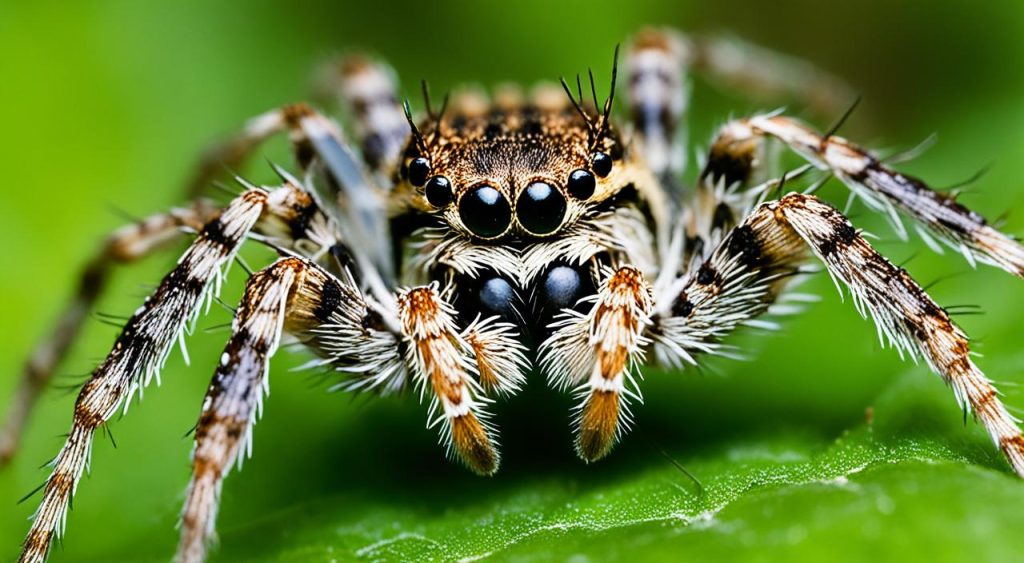
Solitary Hunters: Stalking the Night
Wolf spiders are mostly alone, unlike some spiders that live together. They are great hunters, using their sharp eyes to find and chase their food. They are fast and agile, catching their prey with ease.
Keen Eyesight and Agility
Wolf spiders have amazing eyesight and quick moves. They have four small eyes in the front and another row in a V-pattern at the back. This helps them see well, even in the dark, which is when they hunt.
They also move very fast, catching insects, small animals, and other spiders quickly. Their strong legs and quick movements let them do this.
Courtship Dances and Drumming
Wolf spiders also have special ways of finding a mate. Males do dances and drum with their pedipalps to get a female’s attention. These rituals are different for each type of wolf spider and are quite interesting.
Wolf spiders are skilled hunters with great eyesight and speed. They also have unique ways of finding a mate. These traits help them survive and play an important part in nature as both hunters and prey.
Physical Characteristics of the Wolf Spider
Wolf spiders are fascinating arachnids known for their distinct physical features. They are medium to large in size, with bodies ranging from 0.4 to 1.2 inches long. Their robust build and long, agile legs make them stand out.
Their eyes are arranged uniquely, with eight eyes in three rows. This includes a prominent middle row of four larger eyes. This eye arrangement helps them see their surroundings clearly.
Wolf spiders come in various colors, from dark brown or black to lighter shades with patterns. These colors help them blend into their surroundings, from forests to urban areas. They don’t spin webs to catch prey but use silk for other important tasks.
They produce silk to make protective egg sacs and line their burrows. These burrows are often found on the ground or under rocks and logs.
Size, Eye Arrangement, and Coloration
The family Lycosidae includes around 200 wolf spider species in North America. These spiders can be quite small, just 3 millimeters, or as big as 30 millimeters. Their unique eye arrangement, with eight eyes in three rows, is key to their hunting success.
Silk Production and Burrow-Building
Wolf spiders don’t spin webs for catching prey but are skilled in silk production. Females make delicate, white egg sacs to protect their eggs. They carry these sacs until the spiderlings hatch and leave.
They also use silk to line their burrows. These burrows are usually on the ground or under rocks and logs. This makes their home safe and cozy for their hunting trips.
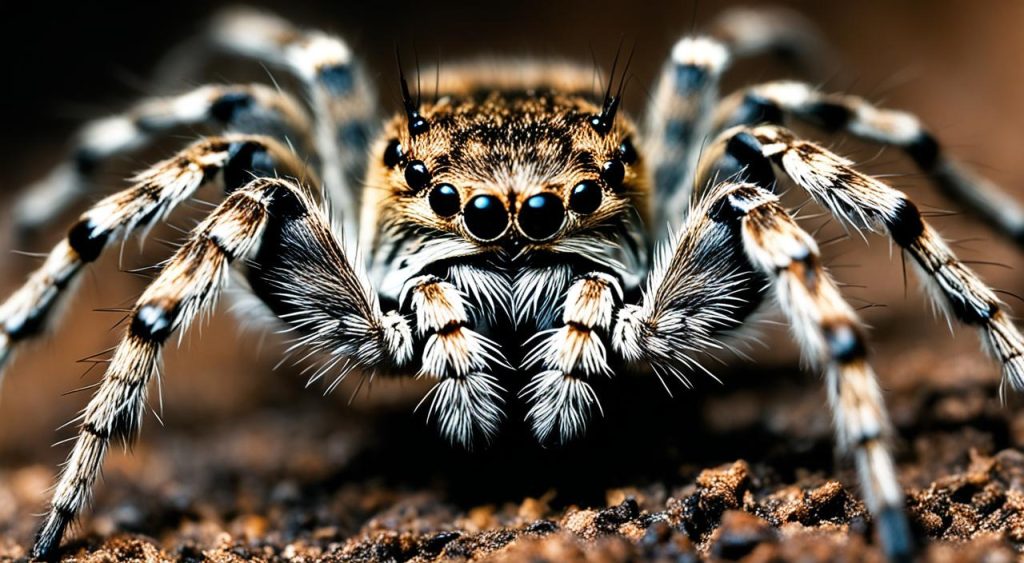
Diverse Habitats: Where Wolf Spiders Thrive
Wolf spiders live in many places all over the world. They can be found in forests, grasslands, and even in deserts. These spiders are amazing because they can live in so many different places.
There are about 2,000 to 3,000 kinds of wolf spiders. They live in urban areas, in the countryside, and even in high places. This shows how well they can adapt and survive.
From Forests to Urban Landscapes
Wolf spiders are great hunters that can move through many kinds of places. In forests, they might live in burrows or under logs and rocks. In grasslands and deserts, they use burrows made by other animals. Some can even climb plants or live in water, showing how wide their living areas are.
Wolf spiders have also made their homes in urban areas. They live in gardens, parks, and sometimes even in our homes. This shows how well they can adapt to places made by humans.
| Habitat | Characteristics |
|---|---|
| Forests | Seek shelter under logs, rocks, and leaf litter; some species climb plants |
| Grasslands | Utilize burrows made by other animals; thrive in open, grassy areas |
| Deserts | Adapt to arid conditions; use existing burrows for shelter |
| Urban Areas | Found in gardens, parks, and even within homes; demonstrate adaptability |
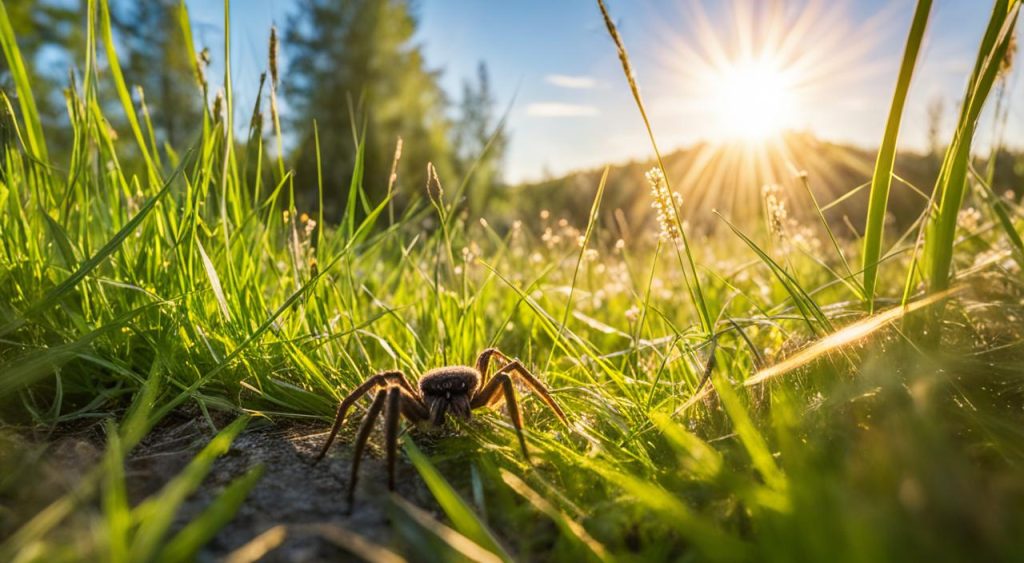
Wolf spiders live in many different places, showing how strong and adaptable they are. They can be found in forests, grasslands, deserts, and even in urban areas. These spiders help make our world’s ecosystems rich and diverse.
Wolf Spider: A Vital Part of the Ecosystem
Wolf spiders are fascinating creatures that play a key role in ecosystems around the world. They are skilled hunters that help control insect and small invertebrate populations. This makes them important in agricultural fields and gardens.
Controlling Insect Populations
Wolf spiders have great eyesight and speed, making them excellent at catching insects. They help keep insect numbers in check, which is good for the health of the ecosystem.
Food Chain and Biodiversity
These spiders are also a food source for birds, reptiles, and small mammals. Their presence adds to the biodiversity of their habitats. This supports a diverse community of species.
It’s important to understand the role of wolf spiders in ecosystems. They are effective predators that help maintain the balance in the food chain. This shows how interconnected our natural world is.
| Ecosystem Contribution | Impact |
|---|---|
| Insect Control | Wolf spiders help maintain the balance of insect populations, reducing the abundance of potential pests. |
| Food Source | Wolf spiders serve as a valuable food source for various animals, supporting the overall biodiversity of their habitats. |
| Biodiversity | The presence and interactions of wolf spiders within the ecosystem contribute to the overall diversity of species. |
Fascinating Facts About Wolf Spiders
Wolf spiders are fascinating arachnids that live in many backyards. They have unique traits and behaviors that scientists study and nature lovers find interesting. Let’s dive into some amazing facts about these creatures.
Wolf spiders have an impressive way of seeing the world. They have eight eyes in three rows, letting them see in many directions at once. They have the third-best eyesight among all spiders, which helps them hunt better.
These spiders can grow quite big. Adults can be between 0.4 inches to 1.25 inches long, with males being smaller than females. While males live about a year, females can live for several years.
- Wolf spiders have eight eyes separated into three groups.
- They possess the third-best eyesight of all spiders.
- Adult wolf spiders can measure between 0.4 inches to 1.25 inches or more in length.
- Males have a shorter lifespan compared to females.
- One species of wolf spider is the state spider of South Carolina.
Wolf spiders live in many places, from forests to cities and by ponds. They can blend into their surroundings with their varied colors. They are great hunters, chasing small insects, other invertebrates, and even small amphibians and reptiles.
| Interesting Wolf Spider Behaviors | Facts |
|---|---|
| Eyesight and Agility | Wolf spiders have 8 eyes arranged in 3 rows They can see in 4 directions simultaneously Can run up to 2 feet per second |
| Reproduction and Offspring | Each egg sack can contain 168-365 eggs Eggs typically hatch in June or July Females carry their spiderlings on their backs |
| Habitat and Prey | Found in diverse habitats, including urban areas Eat small insects, invertebrates, and even small amphibians and reptiles |
These are just a few reasons why wolf spiders are so interesting. Their unique traits, behaviors, and role in nature inspire scientists and nature lovers.
Home Invasions: When Wolf Spiders Come Indoors
Wolf spiders usually stay outside, but they might come inside during cold months. They look for warm, dry places to stay until spring. Recently, seven wolf spiders were seen in a house, showing they can enter homes.
This sudden sight of these fast-moving spiders can surprise homeowners. But, wolf spiders rarely bite people and aren’t a big threat.
To keep wolf spiders out, seal up any cracks and fix screen holes. Use strong-smelling things like citrus, marigold, or mint near doors and windows. These steps make your home less welcoming to the over 1,500 wolf spider species in North America.
Homeowners who find wolf spiders inside can catch them and release them outside. This is a good way to handle spider problems. By knowing what these spiders like, you can stop them from coming into your home. This helps keep your space spider-free.
FAQ
What are wolf spiders?
Wolf spiders are fascinating North American spiders in the family Lycosidae. They are known for their hunting skills and unique behaviors.
How do wolf spiders care for their young?
Wolf spiders are famous for their amazing maternal care. Females carry their egg sacs until the eggs hatch. Then, they help the spiderlings come out. The mother carries the babies on her back for several days, letting them grow before they become independent.
What is it like to witness a mother wolf spider with her spiderlings?
Seeing a mother wolf spider with her spiderlings is a special experience. The mother is covered by the tiny spiders, showing the beauty of nature’s details.
How do wolf spiders hunt and behave?
Wolf spiders hunt alone and don’t live in groups. They use their great eyesight to find and catch their food. These spiders are fast and agile, chasing down their prey. Males also have complex dances to attract females.
What are the physical characteristics of wolf spiders?
Wolf spiders are medium to large, with a body length from 0.4 to 1.2 inches. They have strong bodies and long legs for speed. Their eyes are arranged in three rows, with a big middle row. They come in various colors, from dark to light with patterns.
Where can wolf spiders be found?
Wolf spiders live in many places, like forests, grasslands, deserts, and cities. They can adapt to different environments. They often live on the ground, under rocks, or in leaf litter. Some can even climb plants or live in water.
What is the ecological role of wolf spiders?
Wolf spiders are important in ecosystems as predators. They keep insect and invertebrate populations in check. Their hunting helps control pests in farms and gardens. They also feed other animals, making them key to the food chain.
What are some fascinating facts about wolf spiders?
Wolf spiders have interesting behaviors and traits. For example, females often don’t eat familiar males during mating. They don’t use webs to catch prey; they hunt actively with their eyes and legs.
Do wolf spiders pose a threat to humans?
Wolf spiders might enter homes, especially in the cold months, but they rarely bite humans. To keep them out, seal up cracks, fix screens, and use strong-smelling plants like citrus or mint near doors and windows.
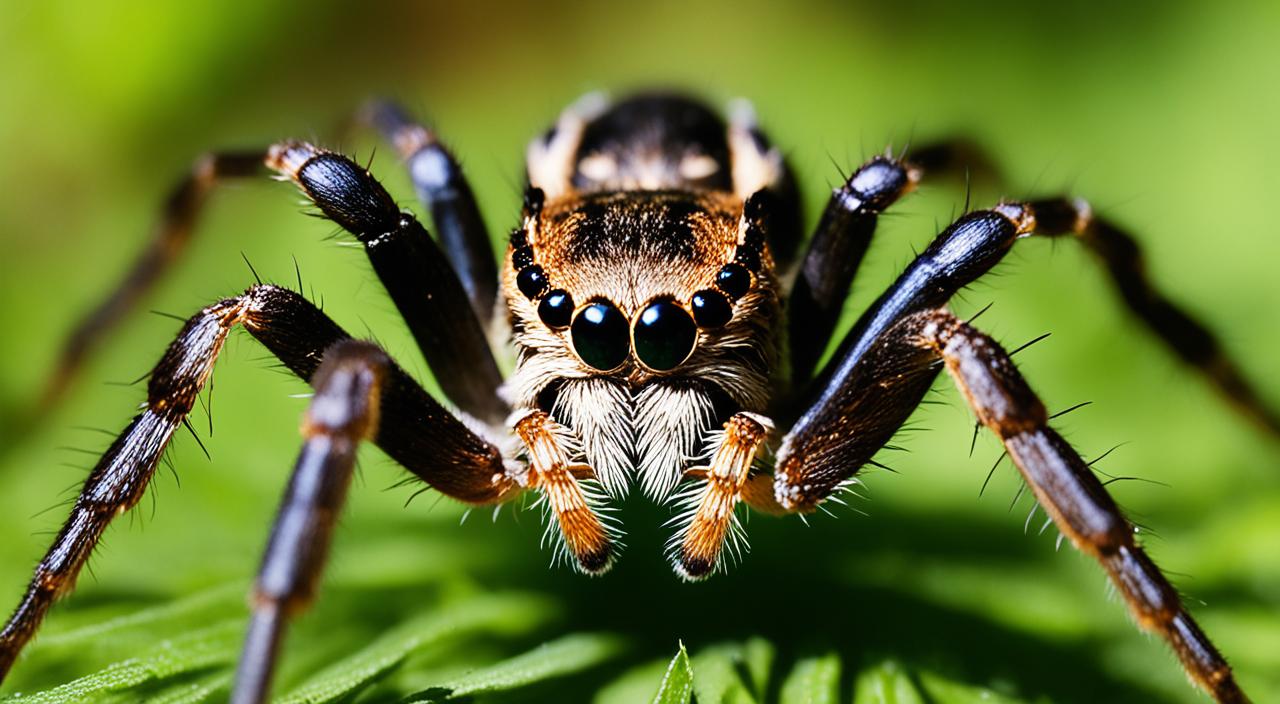
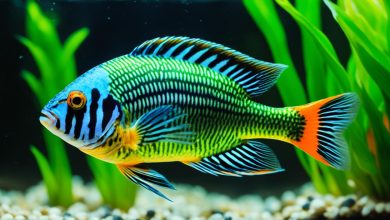
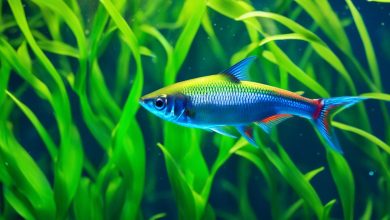

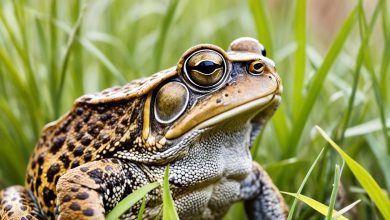
One Comment